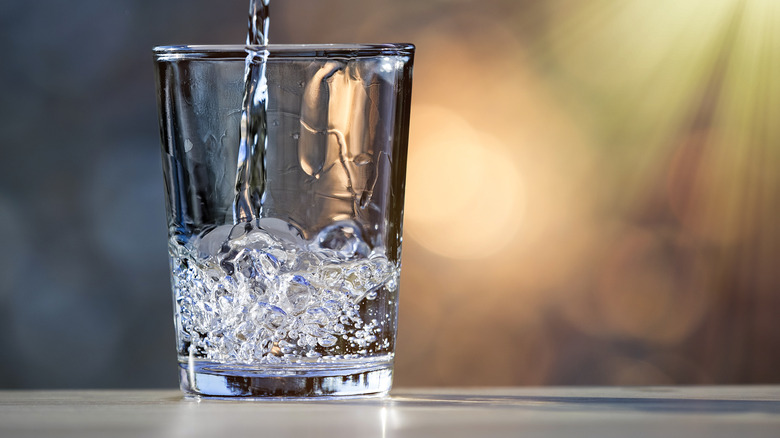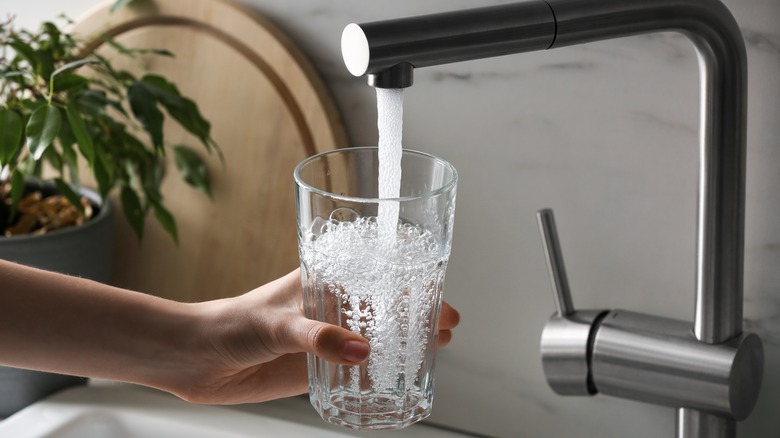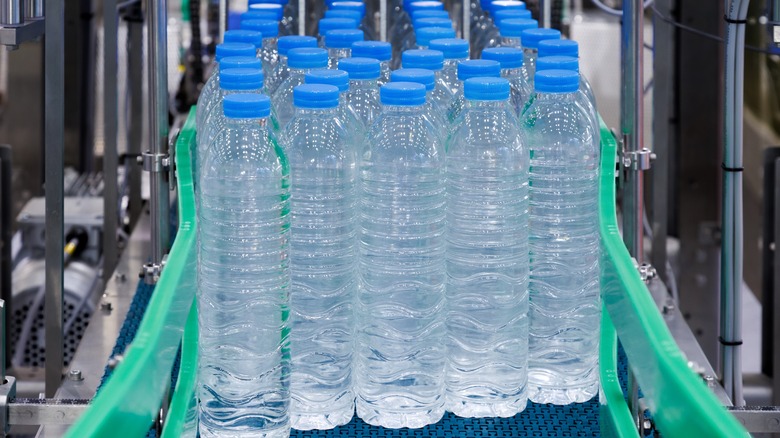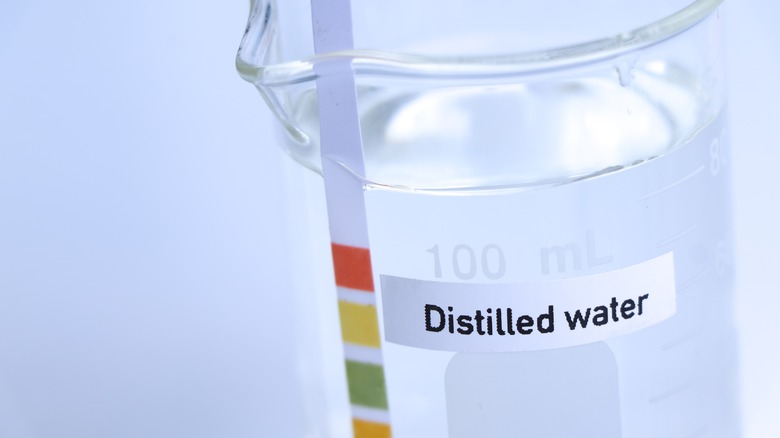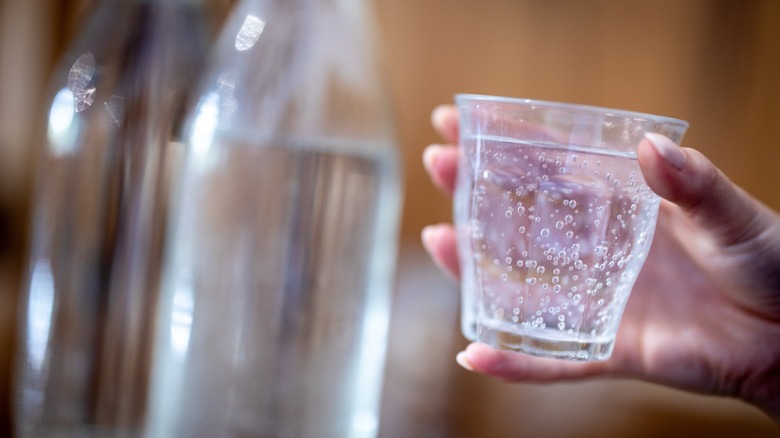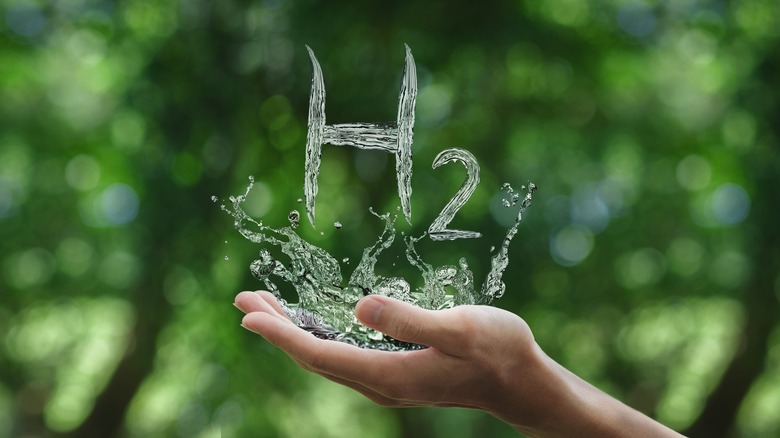10 Types Of Water, Explained
We may receive a commission on purchases made from links.
Water is a vital resource that many of us take for granted. We can only survive around three days without it, and yet we rarely stop to think about where it comes from or the quality of the aqua we consume. In the last few decades, the idea of ditching tap water and choosing a more specialized option has grown, and there are now many varieties of the liquid available in grocery stores and specialist health shops.
From natural spring water full of minerals to distilled water with virtually every dissolved solid removed, there are numerous varieties to consider, each with their own unique qualities. Knowing which option is best — and whether it's worth the price tag — can be tricky. But understanding the differences between them can help you make an informed decision. Below we explore the similarities and differences between water types to make sure you choose the best hydration for both your body and your wallet.
Tap water
We start our list with good old tap water — the everyday hydration that is available pretty much everywhere. If you need to boil your potatoes or make a cup of tea, tap water is your reliable friend. It may not be the most glamorous option, but it does allow you to have some aqua, well, on tap, at virtually no cost compared to the other options.
Tap water is generally considered safe, having been treated with chlorine and UV light to remove bacteria and other dangerous organisms. It has a different flavor to other types of H2O, and the taste can vary depending on where you live. In areas with hard water, for example, there are more minerals like magnesium and calcium. They affect the flavor of the liquid, often causing it to taste bitter or salty. These substances can also be problematic in appliances like kettles. Why? Limescale deposits can leave unsightly marks and make the devices less efficient, meaning they will have to be replaced more often.
Meanwhile, soft water tends to have a more pleasant taste, with fewer minerals affecting its flavor. If you live in an area with particularly hard water and prefer your drink to have a more enjoyable flavor, you can always buy a softener to remove the minerals. Most areas with hard water are located in the Western United States.
Mineral water
Mineral water gets its name from the numerous elements it naturally contains, such as calcium, sodium, magnesium, and potassium. Most of these ions are essential for human health, so drinking it regularly can help keep them topped up. Mineral water originates deep underground and is bottled at source, making it a natural option compared to others that go through chemical alteration.
According to the FDA, mineral water in the USA can only be labeled as such if it contains a minimum 250 parts per million of total dissolved solids (TDS). These elements must be naturally present in the liquid itself — not added later. For those who don't enjoy the taste of tap water, mineral water is probably the better option — it tastes, funnily enough, like water, with a little added flavor. Unlike tap aqua, it hasn't been treated with chlorine, a flavor some people find off-putting.
One of the biggest issues with mineral water is that the majority of it is sold in plastic bottles. This poses environmental concerns, as most people treat these bottles as single-use containers, contributing to landfill and plastic pollution. Reusing them reduces plastic waste, but nasty chemicals such as bisphenol A (BPA) can leach into the water the longer they're used. This is more likely if the plastic reaches high temperatures, so keep your bottles out of sunlight if you're planning to reuse them multiple times. The most responsible way to drink mineral water is to buy it in glass containers, though they can be difficult to find and more expensive.
Spring water
If you are a regular follower of health news, you may have noticed a growing interest in spring water in recent years. This is because it's pretty much the most natural version of aqua that you can find — untouched by chemical processing and with no FDA requirements. Spring water is filtered by the environment, bubbling over rocks and seeping through soil as it picks up lovely minerals along the way. Its mineral content and resulting taste can vary greatly depending on the location, too.
Though you can buy bottled spring water, drinking it directly from the source is a health hobby for many. There is no more instinctive way to consume H2O than to drink it straight from a natural spring, and many people are starting to enjoy the health and spiritual benefits this brings. The site Find a Spring allows you to locate cold water springs near you and has information about locations all around the world. Since the liquid is "raw," drinking it carries the same risks as any other natural, raw food. Most notably, microbes, both good and harmful, could be present. You can purchase home testing kits that flag basic contaminants, but if you are unsure, buying spring water in a glass bottle may be a more reassuring option.
Distilled water
If you want to drink water that contains virtually nothing but hydrating molecules of H2O, distilled water is the best option. Distillation removes almost everything else from the liquid — good or bad — and leaves behind aqua in its purest form. Distillation is a procedure more famously used for alcohol, but the process is the same for water. It works by heating H2O molecules until they turn into a gas, then removing them and cooling them back down into a liquid. This leaves you with a pure version of these molecules, with all impurities left behind. In the case of water, this means that any beneficial minerals will be removed — but so will pathogens, pesticides, and any other nasties that may have been lurking within.
If you're thinking that distilled water sounds like a great option, be warned: Removing all the extras also means that virtually all flavor is eliminated as well. If you're used to mineral or tap water, you will likely be disappointed with the flavor of distilled. However, it may have culinary advantages given that it won't overshadow any other ingredients.
As a rule, distilled water has a more scientific purpose rather than a culinary one, allowing experiments to be performed without the influence of mineral contaminants. If it's your only option for drinking, though, it's perfectly safe — just don't expect the flavor to be very exciting.
Alkaline water
If you studied chemistry in high school, you may be a bit confused at the mention of alkaline water — didn't your science teacher spend weeks trying to get you to understand that water is neutral? Well, yes, regular water is neutral, and alkaline water has been altered to give it a pH higher than 7.
Alkaline water has been making waves in the health industry for a few years now, with many people believing it has benefits that surpass most of the other water types on our list. The concept behind it is that our bodies are overloaded with acidity from sugar, stress, and other environmental factors, and drinking water with a slightly raised pH can help to balance things out.
While some of the more ambitious claims, such as preventing cancer, have little data to back them up, studies have shown that alkaline water could potentially be beneficial in improving acid reflux and bone health. There are two main types available — natural and synthetic. Natural alkaline water has picked up an abundance of alkaline ions like potassium and calcium as it meanders through rocks. Artificial alkaline water is created with a process called ionization, which splits the liquid up into its alkaline and acidic ions and removes some of the latter.
If you're intrigued by the concept of alkaline water, there's no harm in giving it a try — other than the expense (it can cost twice as much as bottled water). At worst, it may be another health claim with little substance. Or it may help to balance out the stresses on your body from our modern diet and lifestyle.
Sparkling water
What is life without a little bubbly?! Sparkling water is your opportunity to enjoy a perfectly teetotal drink that still has the satisfying fizz to keep your taste buds tingling. Any type of aqua that has been carbonated falls into this category, and it has a light fizz and distinctive flavor. It's a bit more exciting than plain old still water, and a great option for those who want to enjoy a bubbly drink without the sugar or sweeteners in soda.
Sparkling water pairs well with a meal in place of a glass of wine or sugary drink. It is extremely refreshing — arguably more so than still water, as the bubbles of carbon dioxide cool the mouth down. It can be used in mocktails to replace prosecco and is a key component of tempura batter, as the bubbles give a light and airy element to the mixture.
To add some flavor to your sparkling water, a wedge of lemon or a squeeze of lime will take it up a notch, and adding fresh fruit juice to it can create a healthier version of your favorite orange soda. No matter how you choose to jazz it up, sparkling water is a welcome change to its still counterpart, especially alongside a delicious meal.
Well water
If you live in an urban area, the thought of your water being sourced from a well may seem a little old-fashioned. However, modern wells are common in rural areas that aren't connected to the municipal water system. They reach deep underground and provide a steady supply of H2O to the property.
Since well water is untreated, it's free of additives such as chlorine that are introduced into municipal tap water. While this can improve the flavor, it also means that there is a higher chance it contains dangerous microbes. Consider using an at-home water testing kit to put your mind at ease.
Well water is also rich in minerals such as calcium and sodium, and it's much fresher from the source than tap water typically is. The difference in composition means that it tastes different as well, which some people love — but it can be an acquired taste. If you're using well water for cooking, it may impart flavor into your dishes in a way that regular tap water would not.
Hydrogen water
Another up-and-comer in the field of healthy H2O is hydrogen water. Also known as hydrogenated water, it has an extra hydrogen molecule added to it, and this addition might impart anti-inflammatory properties. In double-blind studies, hydrogenated water has been shown to decrease inflammation, meaning it could potentially be used in the treatment of many chronic diseases.
The concept behind hydrogen water is that the "free" hydrogen is more easily absorbed by the body, as opposed to in regular water, where it is trapped in a molecule with oxygen. Though pre-hydrogenated water can be incredibly expensive, there are now at-home kits that allow you to add it yourself in the form of a tablet.
In terms of flavor, there is no discernible difference between hydrogen water and regular aqua — after all, it's still just hydrogen and oxygen. But if you're willing to pay a bit extra for a treatment that has shown promising early potential, sipping on a bottle of hydrogen water instead of your usual may be worth a shot.
Purified water
If you've heard the term "purified water" and wondered how it compares to what you usually drink — well, it depends. Many of the water types on this list have been purified in some way, whether to remove bacteria or get rid of virtually all minerals. In a science setting, purified water has three categories. Type III purification is the most basic, removing the worst of the impurities and creating water that can be used for general laboratory needs. Type II needs to be purified further, often using techniques such as reverse osmosis and ion exchange. This allows the water to be used in precise procedures such as preparing buffers — a solution used in food and beverage preparation to control pH levels. The last category is Type III. This water is as pure as it comes and is created using multiple purification techniques to remove all possible contaminants. It's used in highly sensitive situations where the slightest impurity could negatively impact an experiment.
When it comes to drinking water, though, "purified" likely means something different. For example, it may simply refer to water that has been treated to remove contaminants and make it safe for drinking. Realistically, your tap water is a form of purified water, as is any water that has been treated to make it safe for human consumption.
Structured water
At the end of the last century, Japanese scientist Masaru Emoto embarked on innovative research to gain insight on how water can be affected by its environment. He claimed that subjecting water to different "energies," such as love and anger, changed the structure of the molecules within the liquid. According to Emoto, they formed perfectly symmetrical shapes when loving and healing stimuli were present, and haphazard, chaotic ones in the presence of negative ones. Though his theories have been criticized as being pseudo-scientific, they started a discussion around the possibility of changing the structure of water molecules, and a new industry was born.
Structured water that is sold as a health elixir has generally not been exposed to love or gratitude, but rather magnets or ultraviolet light. Those who support the science behind structured water claim that it has a wealth of benefits, including detoxification and keeping glucose levels steady. Although a recent animal study in the Journal of Animal Science suggested there may well be some truth in these claims, there is not yet enough scientific evidence to substantiate them. As studies continue, chances are structured water will grow in popularity, as intrigue around the science captures people's attention. If you want to get ahead of the crowd, you can try it out yourself with this specialized carafe sold on Amazon.
